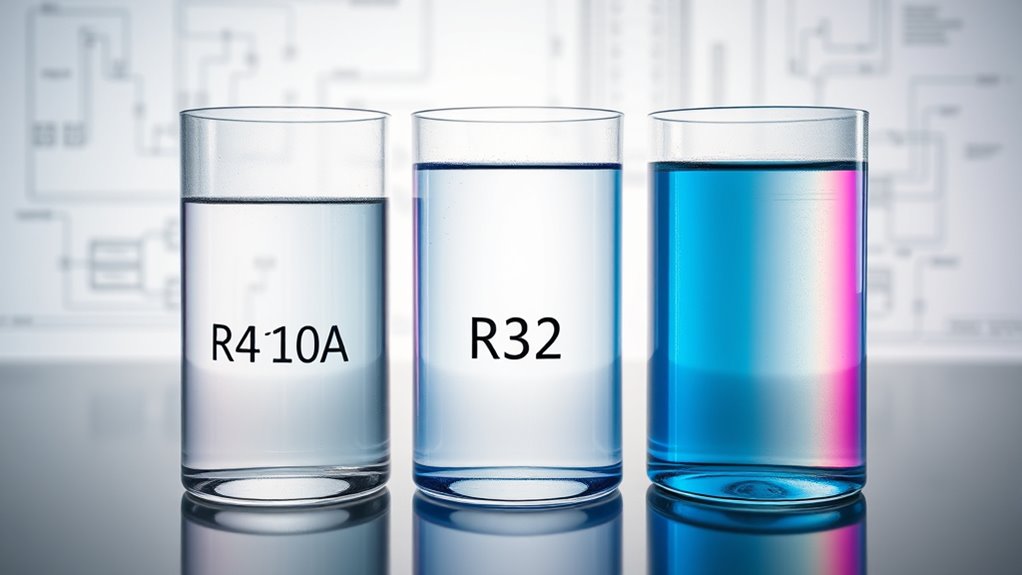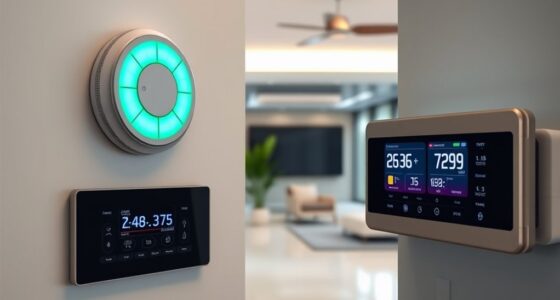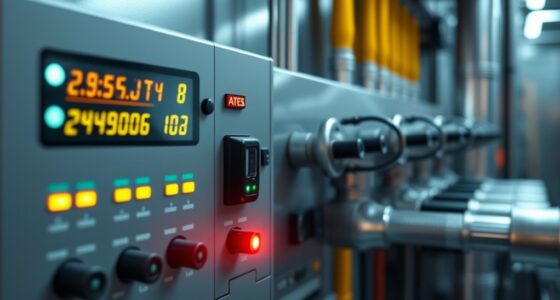When comparing R410A, R32, and future refrigerants, you’ll find R32 offers lower environmental impact with a much smaller GWP and better energy efficiency than R410A, which has a high GWP and is less sustainable. Future options aim to eliminate GWP and ozone depletion, providing eco-friendly solutions that don’t compromise performance or efficiency. To understand how these refrigerants impact your system and the environment, explore the details below.
Key Takeaways
- R410A offers reliable performance but has high GWP, raising environmental concerns, whereas R32 has lower GWP and better efficiency.
- Future refrigerants aim for zero GWP and ozone depletion potential, improving sustainability without sacrificing performance.
- R32 provides higher heat transfer and energy efficiency, reducing power consumption compared to R410A.
- Industry trends are shifting toward eco-friendly refrigerants driven by stricter regulations and environmental commitments.
- Advancements will focus on developing refrigerants that balance high performance with minimal environmental impact.

Are you wondering which refrigerant is best for your cooling system? When choosing between options like R410A and R32, understanding their environmental impacts and energy efficiency is vital. R410A has been a popular choice for many years because of its reliability and performance. However, its environmental footprint raises concerns. R410A is a hydrofluorocarbon (HFC) with a high Global Warming Potential (GWP), meaning it contributes considerably to climate change when released into the atmosphere. While it is energy-efficient in operation, its environmental impacts make it less sustainable long-term. This has prompted the HVAC industry to seek alternatives that balance performance with environmental responsibility.
R32, on the other hand, offers notable advantages in environmental impacts and energy efficiency. It has a much lower GWP compared to R410A, reducing its contribution to global warming. This refrigerant is also more energy-efficient during operation, which can lead to lower electricity bills and reduced carbon footprint over time. Because R32 has a higher heat transfer capacity, systems using this refrigerant often operate more effectively, providing better cooling while consuming less power. This combination of lower environmental impact and improved efficiency makes R32 an attractive choice for both consumers and manufacturers aiming for sustainability.
Looking ahead, future refrigerant options are focusing even more on minimizing environmental impacts while maintaining or improving energy efficiency. New formulations and innovations aim to develop refrigerants with negligible GWP and zero ozone depletion potential. These future options are being designed to meet stricter global regulations on greenhouse gases, ensuring that cooling systems become more eco-friendly without sacrificing performance. As technology advances, you can expect refrigerants that are not only safer for the planet but also optimized for higher energy efficiency, helping you reduce your carbon footprint while maintaining effective cooling.
Frequently Asked Questions
How Do Refrigerants Impact Overall HVAC System Efficiency?
Refrigerants impact your HVAC system’s efficiency by influencing energy savings and environmental impact. Using eco-friendly refrigerants like R32 can boost efficiency because they have lower global warming potential and operate at higher pressures, improving performance. This reduces energy consumption and environmental harm. Choosing the right refrigerant helps your system run smoother, saves money on energy bills, and minimizes your carbon footprint, making your HVAC setup more sustainable overall.
What Are the Cost Differences Between R410A and R32?
You’ll find that R32 refrigerant is generally more affordable than R410A. In regard to cost comparison, R32 tends to have lower initial prices due to easier production and higher efficiency. Price trends show R32’s cost remains steady or slightly decreases, making it a more budget-friendly choice. As regulations favor eco-friendly options, R32’s affordability could improve further, saving you money in the long run.
Are There Regional Regulations Influencing Refrigerant Choices?
Regional restrictions and legislative policies heavily influence your refrigerant choices. Some areas impose bans or phasedowns on certain refrigerants like R410A due to their environmental impact, encouraging you to switch to more eco-friendly options like R32. Staying informed about local regulations is essential, so you can select compliant refrigerants that meet future standards and avoid penalties or system upgrades, ensuring your HVAC systems remain efficient and environmentally responsible.
How Do Refrigerants Affect Indoor Air Quality?
Refrigerants impact indoor air quality mainly through indoor pollution if leaks occur, releasing harmful chemicals. You can reduce risks by ensuring proper ventilation strategies are in place, which help disperse any leaked refrigerants and improve air circulation. Regular maintenance also minimizes leaks, protecting you from potential health issues. Stay proactive about ventilation and leak detection to keep indoor environments safe and comfortable for everyone.
What Innovations Are Expected in Future Refrigerants?
Future refrigerants will focus on alternative refrigerant developments that prioritize environmental friendliness. You can expect innovations like low-GWP (Global Warming Potential) options, natural refrigerants such as hydrocarbons, and improved synthetic blends that reduce ozone depletion. These environmentally friendly options aim to minimize climate impact while maintaining efficiency and safety, helping you adopt greener solutions and stay compliant with evolving regulations.
Conclusion
In the battle between refrigerants, R410A, R32, and future options, staying savvy means selecting sustainable, super-efficient solutions. R410A’s reliability is reassuring, but R32’s reduced environmental impact is promising. As technology takes a turn toward tomorrow, embracing eco-friendly refrigerants becomes essential. By balancing benefits and breakthroughs, you can make smarter, safer choices for a sustainable, more efficient cooling future. Stay sharp, stay savvy, and support sustainable solutions today for a cooler, cleaner tomorrow.









